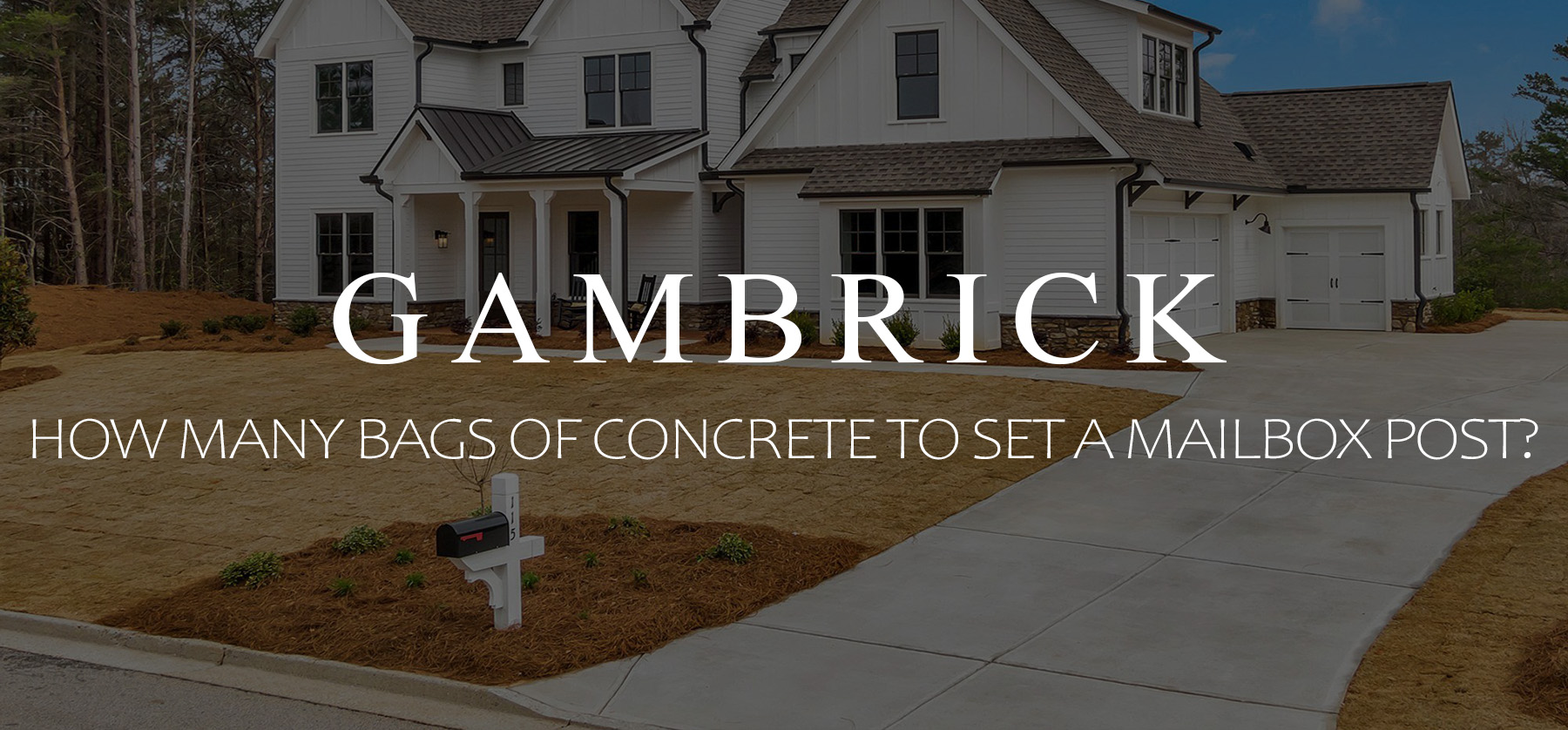
How Many Bags Of Concrete To Set A Mailbox Post?
2–4 bags of 50 lb. concrete are what’s needed to set a mailbox post. But it depends on the type of soil, mailbox design, height, post size and bag weight. In general the depth of the post hole needs to be 1/3 to 1/2 of the above ground height of the post. For example, a 4 foot high fence post should be buried 1-2 feet underground. The diameter of your post hole should be about 3 times the diameter of your post. So, if you’re using a four inch post (4×4), your post hole should be about 12 inches in diameter.
A 5 foot high 4×4 mailbox post would need a hole that’s 20 to 30 inches deep by 12 inches in diameter. But if you use a 5 foot high 6×6 post, the hole would still be 20 t0 30 inches deep but 18 inches wide.
To fill a hole 20″ deep x 12″ wide takes 3 bags of 50lb concrete, but remember, you have to subtract the volume of the post. You also have to stop pouring concrete about 2-3 inches from the top of the hole. This area will be filled in with dirt and landscaping. When you account for the volume of the fence post and not filling the hole all the way to the top, what you need is 2 1/2 bags.
The best way to determine the size of each fence post hole is:
- The diameter of the hole is 3 times the width of the mailbox post
- The depth of the hole is 1/3 to 1/2 the above ground height of the mailbox post
Once you’ve determined the size of your hole, use the chart below to figure out how many bags of concrete you need per mailbox post.
How Many Concrete Bags Per Mailbox Post Chart
Here’s an easy to follow chart to help you determine how many bags of concrete you need per mailbox post.
I figured all the bags at 50 pounds which is equal to a bag of Quikrete Fast Setting Mix. If you want to use different size bags it’s easy to figure out with some basic math. Add the total weight of the bags and then divide by your bag size. For example, a 4″ post with a 12″ hole requires a 10″ depth and 2 x 50 lb bags of concrete. Add them together and you get 100 pounds of concrete. When you divide the total weight by your bag size, lets say 80 pounds, it comes to 1 and a 1/4 bags.
| 3″ Post | 9″ Hole | 4″ Post | 12″ Hole | 6″ Post | 18″ Hole | |||
| Depth | Bags | Depth | Bags | Depth | Bags |
| 10 | 1 | 10 | 2 | 10 | 4 |
| 12 | 1 | 12 | 2 | 12 | 4 |
| 14 | 2 | 14 | 2 | 14 | 5 |
| 16 | 2 | 16 | 3 | 16 | 5 |
| 18 | 2 | 18 | 3 | 18 | 6 |
| 20 | 2 | 20 | 3 | 20 | 6 |
| 22 | 2 | 22 | 3 | 22 | 7 |
| 24 | 2 | 24 | 4 | 24 | 7 |
| 26 | 2 | 26 | 4 | 26 | 8 |
| 28 | 3 | 28 | 4 | 28 | 9 |
| 30 | 3 | 30 | 4 | 30 | 10 |
| 32 | 3 | 32 | 5 | 32 | 10 |
| 34 | 3 | 34 | 5 | 34 | 10 |
| 36 | 3 | 36 | 5 | 36 | 11 |
If you use a tube, check out our article on how many bags of concrete per sonotube. It’ll help you figure out how much concrete you need so you don’t order too much.
If you’re doing a large project, click here to find out how many bags of concrete come on a pallet.
The Weight Of The Mailbox
Alter the amount of concrete bags you use per mailbox post based on the weight of the mailbox you’ll eventually mount to the post.
As a rule of thumb I want my concrete to weigh at least 4 times as much as the mailbox and the post combined. A 4×4 post weighs about 4 lbs. per foot. So if your post sticks up 4 foot from the ground that’s 16 lbs. If you’re using a 20 lb. mailbox that’s a total of 36 lbs. So I want to use at least 144 lbs. of concrete. That’s about 3 x 50 lb. bags of Quikrete Fast Setting Concrete Mix.
The Soil
Another factor to consider are the soil conditions. Here are a few tips to consider:
- I use the standard number of bags in regular dirt.
- If you live in an area with rock hard caliche or clay, you can get away with using less bags since the soil won’t move.
- Sandy soil requires a deeper hole and more bags of concrete. I usually go another 6″-12″ deep with a 2″-4″ wider hole. Sand shifts easily and a strong wind can blow a mailbox right over.
Concrete provides an anchor for the mailbox but so does the soil. The stronger the soil the less support you need from the concrete. Caliche, rock or clay provides a super strong base so you don’t need as much concrete. The chart above is based on regular dirt which provides a medium amount of support. Sand is the worst so you need a deeper hole and more concrete as an anchor for strong winds.
What’s The Best Concrete Mix To Set A Mailbox Post?
Fast setting concrete works great for installing a mailbox post. It comes premixed and is super easy to use. Simply add the right amount of water and pour it into the hole. Or pour it dry without mixing. In my opinion, the two best concrete mixes for setting a mailbox post are:
- Quikrete fast setting concrete mix
- Sakrete Fence post concrete mix
Both of these concrete mixes are a premixed and can be poured into the hole dry. This saves a lot of time and labor. And they both set up in around 20 to 40 minutes which can speed you up even more.
Exact cure times depend on the outside temperature and humidity. Any standard concrete mix will work just fine for setting a mailbox post if your not in a hurry. I just prefer fast setting mixes because of how easy they are too use.
I recommend waiting at least 4-6 hours after the post is set before installing your mailbox. If you use a regular setting mix instead of fast setting you should wait until the next day to install the mailbox. If you mix the concrete I recommend pouring it when the air temperature is between 50 and 90 degrees Fahrenheit and when its dry outside.
The only water you want in the hole is what you pour in. If it’s too hot outside the concrete could crack. Too cold and it won’t cure properly. Both are bad outcomes because they weaken the concrete.
If you pour the mix dry temperature and humidity don’t matter as much. Any moisture in the hole or air will be absorbed by the concrete. However the hole should still be fairly dry. I don’t recommend pouring concrete into a hole that’s full of water.
Should A Mailbox Post Be Set In Concrete?
A mailbox post should be set in concrete because it’s only as strong as it’s foundation. And concrete is very strong and durable. It’s a great way to anchor down a mailbox so that it remains strong and level. This is especially important if you live in a windy area because a lot of force can be created by a wind gust. It’s also better to use concrete if you have a heavy mailbox.
A heavy mailbox pulls the post down in the direction of the mailbox. The more force that’s placed on the post the stronger it needs to be.
Setting a mailbox post in concrete ensures a strong stable base for your posts. This assumes you’ve dug the right size hole and used the correct amount of bags. Digging too shallow or not using enough bags may not provide the level of strength you’ll need.
Here are a few tips to consider when setting your posts in concrete:
- If your using a wooden mailbox post, pressure treated or wood that’s naturally weather resistant will last the longest.
- If you use a wooden post that’s not weather treated, use a preservative or the post will rot.
- Make sure to use a base layer of gravel under the concrete so rain water can drain.
- Taper the top of the concrete away from the fence post to help water drain away from the post.
- Caulk around the post where it comes out of the concrete. A small crack can let water in that can eventually weaken the post.
- Concrete works great as an anchor for metal, concrete or wooden mailbox posts.
How Much Concrete For A 4×4 Mailbox Post?
A 4″ diameter mailbox post needs a hole that’s about 12″ in diameter. The depth below ground should be about 1/3 the height of the post above ground. For example, a 5′ high post will need about a foot and a half deep hole. The chart below will show you how many bags of concrete you need for a 12″ diameter hole at varying depths.
| Depth | 50 Lb Bags |
| 10″-14″ | 2 |
| 16″-22″ | 3 |
| 24″30″ | 4 |
| 32″36″ | 5 |
One bag of Quikrete Fast Setting Concrete Mix weighs 50lbs. If you use a standard concrete mix they come in 60lbs and 80lbs bags. Adjust the amount of bags you need based on the bag size you use.
How Much Concrete For A 6×6 Mailbox Post?
A 6″ diameter mailbox post needs a hole that’s 18″ in diameter. The depth below ground should be about 1/3 the height of the post above ground. For example, a 4′ high post will need about a 16 inch deep hole. The table below shows you how many bags of concrete you’ll need per mailbox post for an 18″ diameter hole that’s between 10″ – 36″ deep.
| Depth | 50 Lb Bags |
| 10″-12″ | 4 |
| 13″-17″ | 5 |
| 18″-21″ | 6 |
| 22″-25″ | 7 |
| 26″-28″ | 8 |
| 28″-30″ | 9 |
| 32″-36″ | 10 |
One bag of Quikrete Fast Setting Concrete Mix weighs 50lbs. If you use a standard concrete mix they come in 60lbs and 80lbs bags. Adjust the amount of bags you need based on the bag size you use.
Cement Or Concrete For A Mailbox Post?
Definitely use concrete instead of cement to set a mailbox post. Concrete is made by mixing cement, stone and sand with water. The stone and sand aggregate provide a lot of strength while the cement binds it all together.
Concrete is extremely strong, durable and weather resistant. And it’s very heavy which makes it a great anchor for a post. There’s a reason why just about every large scale foundation, building, bridge and damn uses it.
Cement is weaker and prone to cracking. It’s a good binding agent, as a very thin coating or as a filler like grout. But I don’t recommend using cement for anything structural like holding up a mailbox post.
Is Quikrete The Same As Concrete For Fence Posts?
Yes. These charts are all figured for 50 pound bags of ready-mix concrete. Quikrete is the brand I typically use but Sakrete is another good one. There are lots of manufacturers that sell factory-mixed bagged concrete. Just make sure you buy the correct PSI for the job you’re doing.
I like to use at least 3500 when setting a mailbox post. I also recommend using fast setting concrete. It makes the job much easier because I can usually install my mailbox in the same day.
Call Before You Dig
For most homeowners, any time you dig anywhere on your property you should call for a mark out. Unless you live somewhere rural with acres of property there may be some under ground utilities you could hit.
Hitting a gas or power line while digging can be very dangerous so make sure your local utility companies mark the lines before you dig.
Here in New Jersey it’s a free service and only takes a few days so there’s really no reason not to call. Also reach out to your local building inspector’s office to find out about zoning, permits or other requirements.
Summary: How Many Bags Of Concrete To Set A Mailbox Post?
1 – 4 bags of 60 lb. concrete are what’s needed to set a mailbox post. But it depends on the type of soil, mailbox design, height, post size and bag weight. In general the depth of the post hole needs to be 1/3 to 1/2 of the above ground height of the post. For example, a 4 foot high fence post should be buried 1-2 feet underground. The diameter of your post hole should be about 3 times the diameter of your post. So, if you’re using a four inch post (4×4), your post hole should be about 12 inches in diameter.
To fill a hole 20″ deep x 12″ wide takes 3 bags of 60lb concrete, but remember, you have to subtract the volume of the post your burying. You also have to stop pouring concrete about 2-3 inches from the top of the hole. This area will be filled in with dirt and landscaping. When you account for the volume of the fence post and not filling the hole all the way to the top, what you need is 2 1/2 bags. The best way to determine the size of each fence post hole is:
- The diameter of the hole is 3 times the width of the mailbox post
- The depth of the hole is 1/3 to 1/2 the above ground height of the mailbox post
If you have any questions or comments about the article E-mail any time.

John Mazzuca | About | More Posts |
Custom Home Builder
John Mazzuca is a custom home designer and builder at Gambrick with over 25 years experience in the construction industry. John has designed, built and/or remodeled hundreds of homes, small buildings, and commercial projects. He writes about business, real estate, home building, and household electronics. His work has been featured in Fox Business, Better Homes & Garden, House Beautiful, and more.




















